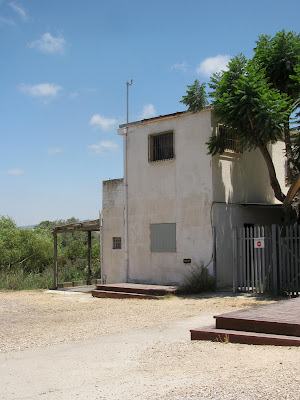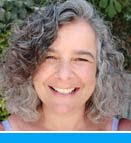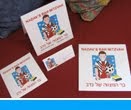Last month Mister Handmade in Israel and I went up north for a few days whilst the boys were at summer camp. Now, you might have guessed by now that I am not the type to sit and sunbathe for days on end. When we go away I like to see the area we are visiting, and this little holiday was no exception. We visited some lovely places, all of which I will blog about at some point, but this post is about Ein Afek Nature Reserve, also known as Tel Kurdani (from the Arabic word kurdan, which means valuable jewel), a lovely spot next to the town of Kiryat Bialik.
The site of the Ein Afek Nature Reserve is what remains of the biblical town of Aphik, which is mentioned in Joshua 19:30 as belonging to the Tribe of Asher. The Ein Afek Spring is in the reserve (afikim means springs in Hebrew), and the reserve is also the last remnant of the Na'aman Stream swamps. In winter, when the water level rises, the reserve shelters pelicans, cranes, pygmy cormorants, grey herons and many other species of water fowl, and in spring the reserve is carpeted with flowers. Ein Afek also has a myriad of bird life, fish, turtles, terrapins, snakes, lizards, otters, coypu and more. Admittedly it was a littlewarm hot on the day we visited, but there was still plenty for us to see and enjoy.
The site of the Ein Afek Nature Reserve is what remains of the biblical town of Aphik, which is mentioned in Joshua 19:30 as belonging to the Tribe of Asher. The Ein Afek Spring is in the reserve (afikim means springs in Hebrew), and the reserve is also the last remnant of the Na'aman Stream swamps. In winter, when the water level rises, the reserve shelters pelicans, cranes, pygmy cormorants, grey herons and many other species of water fowl, and in spring the reserve is carpeted with flowers. Ein Afek also has a myriad of bird life, fish, turtles, terrapins, snakes, lizards, otters, coypu and more. Admittedly it was a little
One of the highlights of the reserve is the two-storey fortress, top, that dates back to Crusader times. An audiovisual presentation in the building showcases the reserve’s flora, fauna and heritage, and the roof provided us with a magnificent view of the surrounding area and, on the flip side, all the development around. A water-powered flour mill operated on the lower floor of the fortress and the ground flour was shipped to nearby Acre in boats via the Na'aman Stream.
We followed the walking trail from the fortress, passing the Mezuda (Fortress) Pools and a dam built during the Crusader period. Vegetation thriving in the Ein Afek wetlands include gibbous duckweed, blue water-lily and pondweed. Watercress can be spotted at the water's edge, while typical riverbank flora includes tamarisk trees, blackberry hedges, reeds, and bulrushes. Crossing over wooden bridges, we were able to experience nature and her water in its many forms – swamp, springs, pond, flowing stream and leafy meadow.
In 1991, seven water buffalo were relocated from the Hula Nature Reserve to Ein Afek and placed in a pen with electric sensors, to prevent them from wandering into the swamp. We spotted them in the distance sheltering under a tree, above. In the past, before the Na'aman swamps were drained as part of preparation of the land for cultivation and to rid it of malaria, herds of water buffalo brought from Egypt lived in the area. They served as work animals and provided milk for Bedouin families. Today the buffalo's grazing load curbs the growth of trees and maintains open pasture.
The largest body of water at Ein Afek is "The Great Lake". A beautiful wooden walkway stretches above the lake, below. Along the way we viewed aquatic plants, birds and fish. The walkway then lead us past the Meshushim (Hexagonal) Spring, which got it's name from the shape of the structure built around it during the British Mandate. A permanent resident of the area is the river crab.
Next was the Suphia (Moorhen) Pool, a small constructed pool where many water and brush birds nest, followed by five tiny pools, the Zeitzer Pools, which are separate from the other bodies of water in the reserve. Zeitzer was a pioneer from Hungary who leased land at the edge of the swamp in 1930 and dug fish ponds. He imported carp from Yugoslavia and continued to raise them till his death in 1945. The remains of his ponds can be seen here. They were a beautiful blue colour, quite different to the somewhat murky waters of the reserve.
Finally, the Eshel (Tamarisk) Pool was built during the British Mandate in the 1930's. It channelled water to the pumping station, which can be seen at the end of the trail, and from here the water was diverted to the oil refineries built north of Haifa. This continued till the 1960's.
The walking trail finally lead us to an ancient tel dating back 4,000 years (the Canaanite period). In ancient times people chose to settle on sites higher than their surroundings in order to protect themselves. They also chose places close to water and which had arable land. Tel Afek met all these requirements. A number of archaeological surveys have been carried out on Tel Afek. Human remains, pottery vessels and tombs have been found. From the top of the tel we went back down the path to the swamp, and returned to the reserve offices where we had started.
Ein Afek was declared a nature reserve in 1979 after drilling in the area nearly caused all the springs to dry up. Now pumping is limited and in years with little rainfall water is pumped into the reserve to preserve the unique vegetation of the area. The reserve covers 366 dunams. A supplementary 300 dunams were added in 1994. We thoroughly enjoyed our visit there!


















































5 comments:
Wow Lisa! This place is beautiful. There is so much nature to enjoy. I love that photogenic turtle! The dragonfly is such a beauty too.
looks like a neat place for a visit! even in the heat. the fish look hungry. turtles always make me smile. :)
Great outing -yes, I heard last week from a friend who's there right now that it's pretty hot - same here! Has been close to a 100 for 2 weeks, only today we have a cool off, because of a lightning storm yesterday night. Love the red dragonfly (?) and the turtle, of course also the palm trees in your last pic.
SEASONS resumed on Sunday after a blog break, so a kind reminder to include one of your trip before Wednesday 7 pm Pacific time.Hope to see you there, and have a great week
How great to get away for a while and it's awesome to visit such a great historical place like the Biblical town! You took a lot of fabulous shots. The dragonfly macro really caught my eye, but they are all lovely shots. Thanks for sharing.
SO much to see and to react too - it's neat that it's such a historic place. I know carp from Holland, but am not sure if they have carp in the USA. IS that pink oleander that I see? IN California we see it often - thanks so much.for sharing such an interesting and beautiful place with SEASONS! does school start a little later in Israel? Have a great week!
Post a Comment